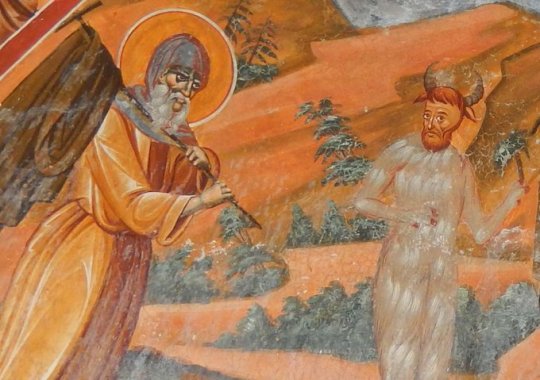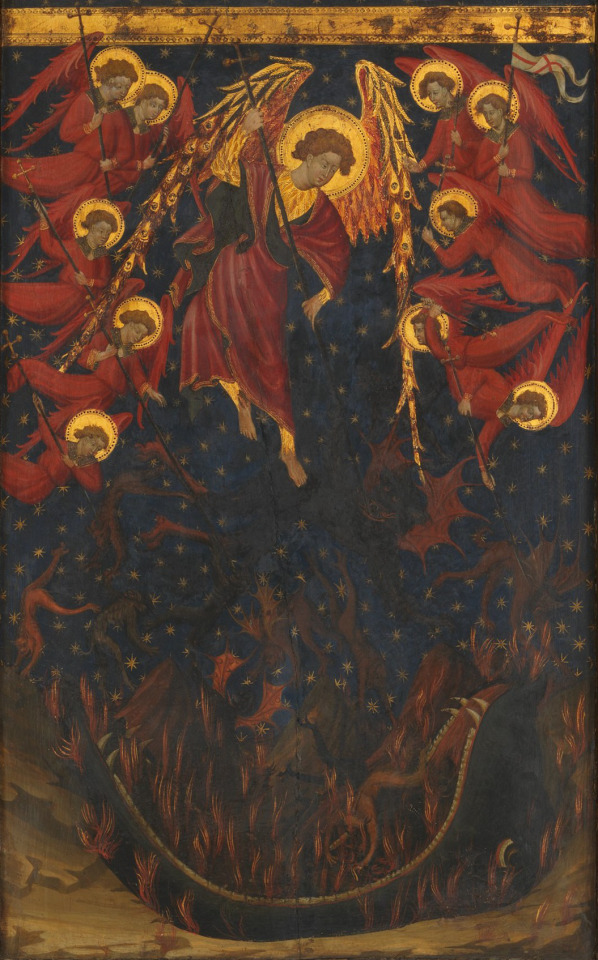#early christian saints
Explore tagged Tumblr posts
Text
11th April
St Guthlac’s Day

Saint Tormented By Demons. Source: Deor Reader website
Today is St Guthlac’s Day. Guthlac was as austere as they come which made him one of the most popular saints in pre-Conquest England, only really eclipsed by St Cuthbert. His toughness is perhaps explained by the fact Guthlac began life as a soldier before converting to the life of a monk. He joined the monastery at Repton but his aversion to sex and alcohol made him an outsider amongst the allegedly holy community in these days of pre-Benedictine monastic reform, so he left Repton for the bleakness of the Lincolnshire fens where he became a hermit, residing in Crowland, in those days only accessible by boat. Living a solitary ascetic existence, Guthlac’s only companions were a troop of demons who regularly tormented him, insulting the Saxon hermit in Welsh and generally making his life a misery. Guthlac was comforted by visits of angels and by his patron, St Bartholomew. It was the long-dead Bartholomew who equipped Guthlac with a whip with which to drive away the demons, and the whip then became the saint’s symbol.
It is said in Fishtoft in Lincolnshire that so long as Guthlac continues wield his scourge, the village will forever be free of rats and mice.
1 note
·
View note
Text

The Dance of the Beatified
Detail from The Last Judgement by Fra Angelico (c. 1425)
#fra angelico#art#painting#tempera#Catholic#Christian#last judgement#early renaissance#renaissance art#renaissance#detail#all hallows#all hallows eve#halloween#all saints
355 notes
·
View notes
Text

Saint Margaret of Antioch. French ca. 1475
The Metropolitan Museum of Art
The legend of Saint Margaret, the Early Christian martyr also known as Marina, details the many painful ordeals she endured before her eventual death during the reign of Emperor Diocletian (r. 284–305). Having been swallowed by the devil in the guise of a dragon, the saint burst unharmed from its body after making the sign of the cross.
Dating from about 1475, this work is an outstanding example of the Languedoc style of the late fifteenth century, which was centered in medieval Toulouse. This work is remarkable for the contrast of the idealism and delicacy of the figure set against the scaly and coarse textures of the lizard-turned-dragon at the base of the composition.
79 notes
·
View notes
Text

The Exhumation of Saint Hubert (Saint Hubert Altarpiece) by Rogier van der Weyden, late 1430s.
#classic art#painting#rogier van der weyden#flemish artist#15th century#renaissance#northern renaissance#early netherlandish#christian art#saints#saint hubert#clergy#people#columns#palatial interior
38 notes
·
View notes
Text

The Trinity Adored by All Saints, Spanish Painter (ca. 1400s) https://www.youtube.com/watch?v=yTLW5QQM1N8
#art#european art#christian art#early christianity#christentum#The Trinity Adored by All Saints#Tempera and gold on wood#gold leaf#fine art#classical art#europe#european#oil painting#fine arts#europa#mediterranean#southern europe#catholic#catholicism#angel#angels#The Trinity#Saints#Martyrs#hispanic
250 notes
·
View notes
Text

"Jesus became what we are, that He might make us what He is." Saint Athanasius
Artist's Instagram
Artist's Facebook
#psalmprayers#psalm prayers#God#Christ#Jesus#Jesus Christ#Athanasius#Saint#Saint Athanasius#incarnation#early church#Christianity#Coptic#Alexandria#art#block print
15 notes
·
View notes
Text

Conversion of Saint Paul on the Way to Damascus
Artist: Caravaggio (Italian, 1571[2] – 1610)
Genre: Religious Painting
Date: 1600 - 1601
Medium: Oil on Cypress Wood
Collection: Odescalchi Balbi Collection, Rome
The Conversion of Saint Paul (or Conversion of Saul), by the Italian painter Caravaggio, is housed in the Odescalchi Balbi Collection of Rome.
The painting records the moment when Saul of Tarsus, on his way to Damascus to annihilate the Christian community there, is struck blind by a brilliant light and hears the voice of Christ saying, "Saul, Saul, why persecutest thou me?… And they that were with me saw indeed the light, and were afraid, but they heard not the voice…" (Acts 22:6-11).
#religious painting#conversion of saint paul#damascus#horse#fall#christian comunity#early 17th century painting#caravaggio#conversion of saul#saul of tarsus#bible verse#new testament#book of acts#christianity#christian art
8 notes
·
View notes
Text

Dragon Age: The Missing #2
Writer: George Mann Artist: Fernando Heinz Furukawa (going by the cover; comic description blurb appears to be mistaken) Colorist: Michael Atiyeh Covert artist: Matt Taylor
On sale: 2/22/23
Plot synopsis & links under cut:
After their close encounter in the Deep Roads under Marnas Pell, Varric and Harding continue their quest to find Solas. An invitation to the home of Lady Chrysanthus in Vyrantium puts the pair on a course that will cross paths with the Venatori, as well as deadly Antivan Crow assassins...
[source, two] [issue 1 details]
#dragon age: dreadwolf#dragon age 4#the dread wolf rises#da4#dragon age#solas#dragon age: the missing#bioware#video games#so it is Solas that they're looking for after all!#sometimes the most obvious answer is the one :D#Chrysanthus seems to be a new char#chrysanthus was an early christian saint and its also part of the latin name for a species of crocus meaning goldenflowered#and harding gets a cover page!#love that#is that teia and viago!!
215 notes
·
View notes
Text

35 notes
·
View notes
Text
Lamb of God: Horus, Christ, and the Labarum
The development of the Sun-god archetype in Early Christianity was shaped by the preceding language and symbolism of Egyptian and Greco-Roman religions. When Constantine first beheld the vision of the labarum, the prevailing patterns of syncretism had already provided a shape and direction for the form that the early Christian Sun-god would take. It was represented by the Greek symbol of Chi-Rho.…

View On WordPress
#Ancient Egyptian relgiion#Apollo#Asklepios#astrotheology#Bacchus#Chi-Rho#Comparative Religions#Constantine#Dionysus#DM Murdock#EA Wallis Budge#Early Christianity#egyptian mythology#Gerald Massey#greco-roman religions#Horus#Isis#Jesus Christ#late antiquity religions#Magick#mysticism#Mythology#Nigel Pennick#Ophiuchus#perfected saints#Sir Flinders Petrie#Sol Invictus#Spirituality#Symbolism#the cult of the sun god
5 notes
·
View notes
Text
17th November
St Hilda’s Day

Saint Hilda of Whitby by LieutenantPanzer1917 on Deviant Art
Today is St Hilda’s Day. Hilda was converted to Christianity by St Paulinus in 627 and, being of royal descent, rapidly became one of the leading female figures in the growing Anglo-Saxon church. She eventually founded the abbey at Whitby which played host to the defining debate of early Christianity in the British Isles between the bishops of the Roman Church (who had been converting the pagan English) and those of the Celtic Church (which could trace its roots back to the introduction of Christianity to Britain under the late Western Roman Emperors), over the date of Easter. The epic encounter was won by the Roman Catholics and Hilda, despite preferring the Celtic practice, dutifully promoted the Roman doctrine henceforth.
Hilda, renowned for her piety and good works, allegedly ascended to Heaven in 680, and Whitby Abbey became her shrine. Viking attacks over a century later, forced the removal of the saint’s bones and they appeared in Glastonbury and Gloucester, both of whom became sites of pilgrimage. For all the heartfelt devotion to Hilda, particularly by the poor, both sets of relics disappeared during the Reformation.
0 notes
Text

‘Whosoever is delighted in Solitude is either a Wilde Beast or a God’ FRANCIS BACON (1561 – 1626) Essays, On Friendship Art: St Anthony and the Satyr
Story behind the art, roughly paraphrased from what I remember in the Vita Antonii (of Athanasius): While in the desert, Saint Anthony, then just Anthony, met a centaur and a satyr (thin on the ground but still something you could find in the late Roman Empire, especially in the deserts and wild places). They mocked him for being a Christian and then Anthony converted them through prayer, because that's how these things go. The centaur gave Anthony directions to find a friend and fellow hermit and the satyr asked for a blessing. As far as Saint Anthony's adventures, this was probably a fairly normal Tuesday afternoon for him.
3 notes
·
View notes
Note
Hey, sorry that Valentine's is so hetero and amato normative instead of being the day celebrating a star crossed friendship between a missionary and the blind noblewoman nobody else treated as a person but him.
But deep down we all know that Valentine’s Day is ACTUALLY about Draculaura’s Birthday
#also the og saint Valentine was BADASS#early Christians had no chill they were like yeah execute me see if I care
12 notes
·
View notes
Text

Virgin and Child with Saints and Donor by Jan van Eyck, 1441-1443.
#classic art#painting#jan van eyck#flemish artist#15th century#renaissance#early netherlandish#christian art#virgin mary#baby jesus#virgin and child#saint barbara#elizabeth of hungary#clergy#nuns#palatial interior#balcony#columns#buildings
42 notes
·
View notes
Text

The Trinity Adored by All Saints, Spanish Painter (ca. 1400s)
#art#european art#christian art#early christianity#christentum#The Trinity Adored by All Saints#Tempera and gold on wood#gold leaf#fine art#classical art#europe#european#oil painting#fine arts#europa#mediterranean#southern europe#catholic#catholicism#angel#angels#hell#demons#western civilization#hispanic
113 notes
·
View notes
Text

Feast Day:
The Forty Holy Martyrs, Ora Pro Nobis
#The Fourty Martyrs#Forty#Feast day#fourty#ora pro nobis#oremus#God#honor#testimony#early christianity#catholic saints#catholic saint quotes
11 notes
·
View notes